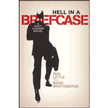
HAPPY NEW YEAR!!! It is January 1st, time for the FIRST Day Blog Tour! (Join our alliance! Click the button!) The FIRST day of every month we will feature an author and their latest book's FIRST chapter!
This month's feature author is:
Phil Little with Brad Whittington
and their book:
(A Matt Cooper Novel)
ELEVEN BRIEFCASES AND ONE UNLIKELY HERO...CAN MATT COOPER FIND ELEVEN NUCLEAR DEVICES AND HIS FAITH BEFORE DISASTER STRIKES?
With violence in the Middle East escalating daily, Americans are glued to their televisions wondering what will happen next. Meanwhile, Matt Cooper, jet-setting star of Phil Little's debut novel Hell in a Briefcase is doing something about it. A private security executive, his adrenaline-junkie days consist of last-minute first-class overseas flights, Hollywood parties with his actress girlfriend, and direct calls from top CIA brass.
A chance meeting with Mr. Roberts, “an old broken-down millionaire” and uncommon Christian, sends Cooper on a trip to Israel that will change his life. Matt goes behind the curtain of Middle East terrorism, witnessing firsthand the untold ravages of holy war. The deeper he goes, the closer he gets to a plot involving eleven stolen briefcase nukes and a plan infinitely more sinister than 9/11.
ABOUT THE AUTHOR:
Phil Little, president of West Coast Detectives and a recognized expert in counter-terrorism, provides bodyguards to the stars and runs a detective agency that has served ABC, NBC, CBS, CNN, FOX, Paramount, MGM, and hundreds of others (www.westcoastdetectives.us). He draws on this experience in crafting the tightly wound plot of this international thriller. In addition to his duties as a security expert, Phil has also written Hostile Intent, Protecting Yourself from Terrorism and will soon be the subject of a television pilot. In the meantime, you can read more about Matt's adventures in his blog, http://detectivemattcooper.blogspot.com.
In addition, Phil is available for comment on all aspects of international terrorism, both at home and abroad, and he makes for an interesting and colorful guest. His expertise in the area of international issues combined with his personable on-camera style would make for a great interview on this hot topic. From Lebanese terror camps in the 1970’s to American airports in the months before 9/11, Phil Little has witnessed the terror threat up close and can share eye-opening stories and information that all Americans should know.
THE FIRST CHAPTER:
Marjeyoun, Lebanon.
Thursday, 21 November 2002. 01:30.
A full moon. A glow seemed to rise from the sand, allowing them to drive with their headlights off. The five Jeeps kept to 40 kph on the dark road that wound southward between hills and wadis. In the third Jeep, Major Skaff allowed himself the brief luxury of picking out Pegasus in the sharp winter sky before he compulsively scanned the rocky terrain for signs of Hezbollah fedayeen. He was leading this patrol to check out rumors of increased activity near Shaaba Farms, the disputed area where three Israeli soldiers had been kidnapped two years before.
The ridge road ran from the town of Marjeyoun down to Qlaia’a under the ominous gaze of Shqif Arnoun-the castle called “Beaufort” by the Crusaders-to the west. Christians and Muslims had fought for this ground for centuries, trading possession of the castle as their fortunes rose and fell. In the 1970’s the Palestinian Liberation Organization had used the strategic placement of the castle to shell civilian settlements in northern Israel.
That was when Skaff, then a young recruit of the Southern Lebanese Army, had been a driver in a similar convoy, shortly before the civil war broke out between Christians and Muslims in 1975. Traversing this very ridge on a mission, he had come under fire from the castle. His evasive driving had saved the convoy and drawn the attention of General Lahd.
The intervening thirty years had been a generation of unremitting war. Israel, tiring of mounting civilian casualties and the Lebanese government’s refusal to expel the terrorists, invaded southern Lebanon in 1982 and captured the castle. Eighteen years of occupation followed, during which Skaff had risen through the SLA ranks while working openly with the Israelis to keep the various Muslim factions at bay. When he had started, Hezbollah did not exist. Now the radical Muslim army controlled the south and dealt severely with the Christian resistance.
As the occupation had grown increasingly costly and casualties mounted, the pressure increased for Israel to withdraw. When the SLA collapsed in 2000, Israel destroyed what was left of the castle walls and pulled back behind the Blue Line specified by the UN. The SLA scattered. Thousands fled to Israel or went into hiding. Those who didn’t were imprisoned and tried as enemy collaborators. As Hezbollah gained control of the area, the anticipated slaughter of Christians didn’t materialize. But any SLA militiamen emboldened to return were also imprisoned.
As he scanned the distant ruins of the castle in the moonlight, Major Skaff reflected on change and constancy. Where PLO guns had once rained death on Israel and Lebanese Christians, now tourists snapped pictures and rushed home to post them on the Internet. And the same General Antoine Lahd who had brought him up in the ranks and fought beside him for decades had fled to Paris. Only a week ago he had opened a fancy restaurant in Tel Aviv called Byblos. It had a nice ocean view.
True, Lahd had a death sentence hanging over him for treason and war crimes, but so did Skaff. And so did many of the two thousand SLA in Lebanese prisons.
But some things had not changed. Southern Lebanon was just as dangerous for the men in these Jeeps as it had been when Skaff was driving instead of commanding.
To finish chapter 1 go to the FIRST blog site mentioned above...

No comments:
Post a Comment